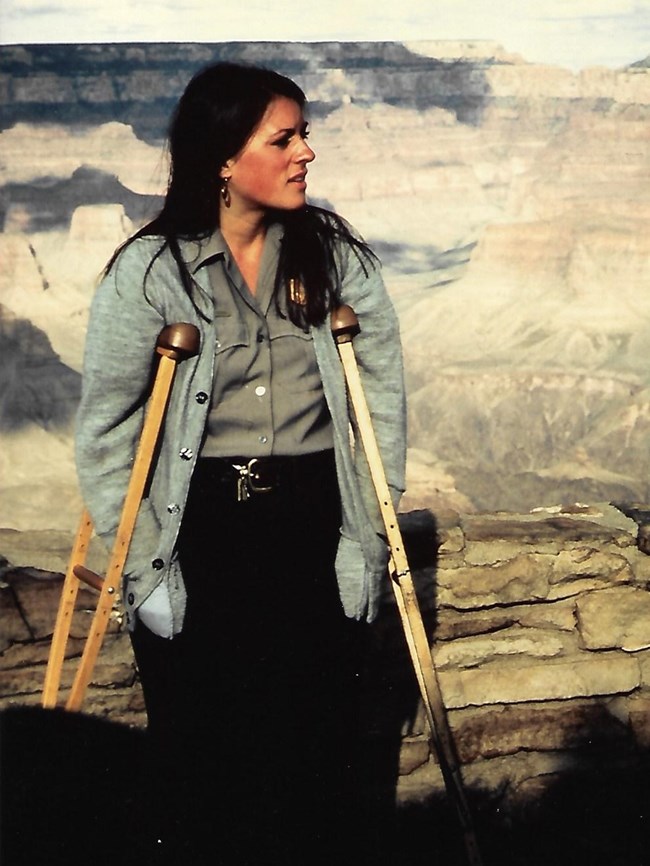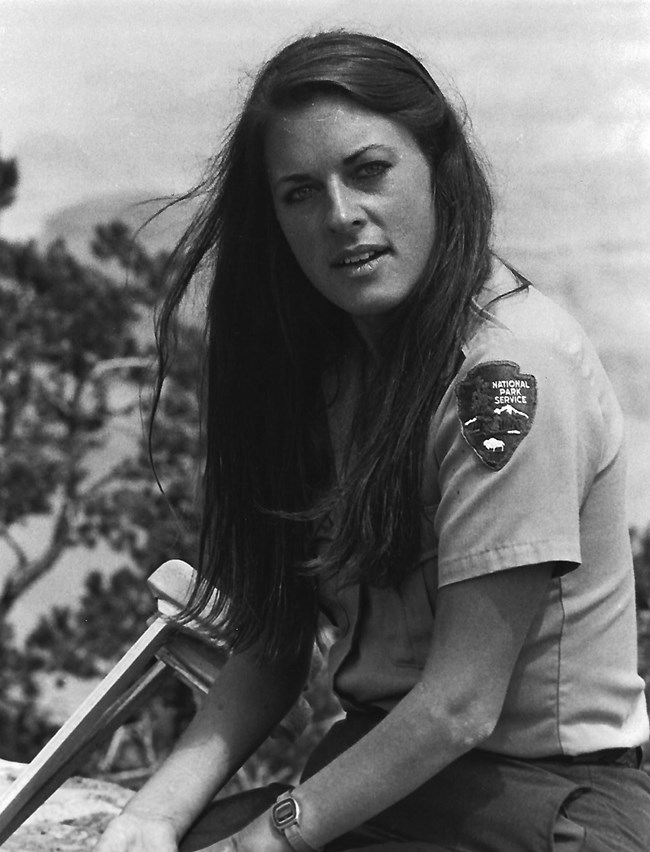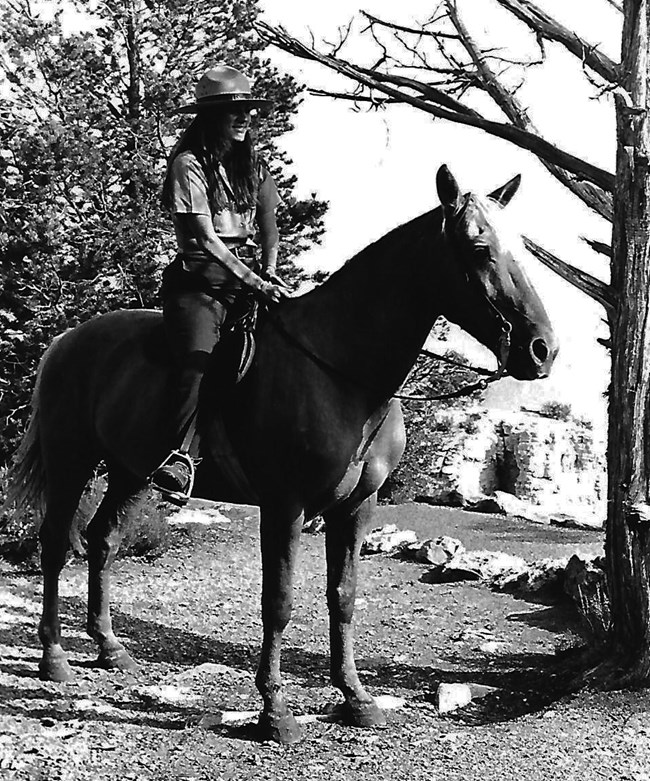Part of a series of articles titled Whose Story is History? The Diverse History of Grand Canyon.
Article
Eileen Szychowski: Expanding Access at Grand Canyon

Photo by Mike Valentine, courtesy of Eileen Szychowski
Eileen Szychowski expected to ride a mule when she visited the Grand Canyon in 1981. But a visitor center policy prohibited people with physical disabilities from participating in the iconic trip from canyon rim to canyon bottom on the back of a mule. Szychowski, an expert horsewoman, knew her legal rights and insisted on speaking with park managers. Met with support by National Park Service staff, Szychowski left Grand Canyon with an offer to return as a seasonal park ranger committed to access and disability rights.
“How to Develop a Thick Skin 101”
In 1964, when she was 11 years old, Szychowski contracted a rare neuromuscular disease. Her family, then living and working on a military base in Germany, flew to Walter Reed Hospital in Maryland. She spent several months in rehabilitation there and continued therapy in hospitals in California where her family later moved. The disease paralyzed sensory and motor abilities, and it impacted all of her extremities. Szychowski eventually regained control over much of her body, but she lives with residual paralysis in her limbs. She continues to use crutches, leg braces, and a power chair.
After years in and out of the hospital, Szychowski struggled upon returning to the classroom. She was not used to playing with children her age, and she found that peers and teachers discriminated against her disability. It wasn’t easy navigating school or receiving accommodations. It was during these years that she learned what she calls “How to Develop a Thick Skin 101.”
-
Eileen Szychowski: Navigating the Classroom
In a 2022 oral history interview with the Park History Program, Eileen Szychowski describes some of the difficulties she encountered in school as a result of both discrimination and lack of accommodations for students with physical disabilities.
- Credit / Author:
- NPS Park History Program
- Date created:
- 06/22/2022

NPS / C. Rudd
When she arrived at college, however, Szychowski found disabled peers and joined the Disabled Students Union. Always an outdoors enthusiast, she was thrilled to participate in a cross-disability camping trip in California’s Sierra Nevada mountains. Those college years, followed by her later work at a vocational training center, instilled her first inklings of disability pride.
Szychowski found work as a case manager in 1978 at a vocational skills training center for people with mental illness and developmental disabilities. In her free time, she rode horses under the tutelage of Josef Rivers. Rivers, also disabled, offered a therapeutic riding program free of cost for people with disabilities. Rivers used various techniques and adaptive equipment, and he encouraged Szychowski’s lifelong passion for horseback riding. Eventually she would ride horses three times a week and become an expert in various riding styles. Impressed by her skill and interaction with others, Rivers offered that, someday, Szychowski could take several of his horses and begin her own therapeutic riding center. Though she enthusiastically accepted, Szychowski promised to reflect on this offer for one year before deciding to commit.
Knowing Her Rights
With friends from the vocational skills center, in 1981 Szychowski visited the Grand Canyon. Her friends went backpacking while she intended to ride a mule into the Canyon, an experience that is a trip highlight for thousands of visitors. At the Bright Angel Lodge, a front desk employee explained that she was not allowed to ride the mules because of her physical disability. Szychowski, hurt and disappointed, knew her rights as outlined by the 1973 Rehabilitation Act as amended. After dropping her friends off at the trail head, she returned to Bright Angel Lodge. She respectfully demanded access.
-
Eileen Szychowski: Knowing her Rights
Eileen Szychowski describes an experience during a 1981 visit to Bright Angel Lodge in Grand Canyon National Park, when she informed the staff that their preventing her from riding a mule because of her physical disability was a violation of the 1973 Rehabilitation Act.
- Credit / Author:
- NPS Park History Program
- Date created:
- 06/22/2022
Szychowski proceeded to meet with Jan Cutler, director of the department who oversaw the mule ride. He then introduced her to Karen Berggren, special populations coordinator at Grand Canyon. Prior to its renaming as the Accessibility Program, the National Park Service oversaw a “special populations program.” Berggren, in turn, took Szychowski to Albright Training Center, where instructors invited her to make a presentation on disability and accessibility at a ranger skills course a few months later. Grand Canyon Superintendent Richard Marks was so impressed by Szychowski’s knowledge and horseback riding experience that he offered her a seasonal job as park ranger the following year, in 1982. She heartily accepted.
“Just Another Way of Being”
As part of her job as park ranger, Szychowski worked at the Yavapai Museum of Geology. She and colleagues immediately noticed that visitors misunderstood her use of crutches and joked that she must have fallen in the canyon. In response, as she met hundreds of visitors, she took the opportunity to change nondisabled people’s attitudes toward disability.
-
Eileen Szychowski: A Way of Being
During an oral history interview with the Park History Program, Eileen Szychowski describes how her interactions with people in her job as a park ranger gave her opportunities to challenge nondisabled people's conception of disability.
- Credit / Author:
- NPS Park History Program
- Date created:
- 06/22/2022

NPS / C. Rudd

NPS / C. Rudd
When Szychowski led programs or chatted with visitors, she often preemptively addressed her disability instead of allowing people to make assumptions or crack jokes about why she used crutches. She also made sure to address resistance or discrimination she encountered from some individuals who worked at the park. While rare, these instances required swift action. Szychowski was surprised and touched by the support she received from colleagues when these discriminatory or hurtful interactions occurred.
Many Different Tracks
Szychowski also proved her riding skills to the staff at Grand Canyon. It was important for her to use her own horse Guinevere, who understood Szychowski’s riding style. Once Guinevere adjusted to the climate and terrain, they took off with Eldon Bowman, a friend and outfitter, for a two-day ride into the Canyon. The journey was spectacular. Venturing deeper into the rocky expanse, Szychowski rode toward the Colorado River, what she calls the “beating heart of the Grand Canyon.”
They spent a night at Phantom Ranch and awoke early to continue on their way. Before leaving, however, she asked if they could visit the Colorado River. With support from her companion, she dismounted the horse and walked to the river’s edge. She was struck by the many different animal tracks imprinted in the riverbank’s wet sand.
-
Eileen Szychowski: Belonging
Eileen Szychowski describes an experience while horseback riding to the Colorado River in the Grand Canyon, where tracks in the wet sand of the riverbank left her with a powerful feeling of being "a part of the natural order of things."
- Credit / Author:
- NPS Park History Program
- Date created:
- 06/22/2022
Szychowski’s 1982 season at the Grand Canyon was transformative. She expanded access for current and future colleagues, learned about natural and cultural resources interpretation, and explored the spectacular landscape. But Szychowski also knew she would not stay. She was ready to accept Josef Rivers’s offer to take a few of his horses and begin her own therapeutic riding center.
When she left the Grand Canyon, Szychowski recommended several people with disabilities to hire as future seasonal park rangers. She also left having educated her nondisabled NPS colleagues on the necessity for access and challenging assumptions about disability and capability. Szychowski acknowledges that people with disabilities and from other marginalized communities still face barriers to work and full participation in public spaces, in and outside the NPS.
In 1983 Szychowski moved to Phoenix and built a network of disabled and nondisabled allies. Though she retired in 2004, she delights in knowing that her therapeutic riding center, Camelot, continues to run successfully and free of cost for all riders to enjoy.

NPS / C. Rudd
Last updated: July 29, 2022
